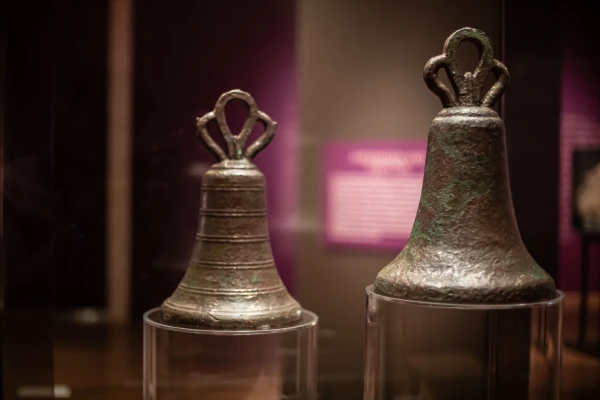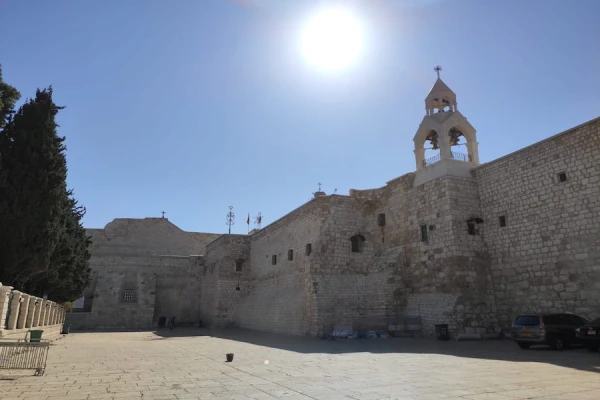Washington D.C., Jan 3, 2023 / 09:00 am
A special Christmas “Bethlehem Bells” exhibit at the Museum of the Bible is bringing the Holy Land to Washington, D.C.
The bronze bells that once graced the ancient Church of the Nativity in Bethlehem have traveled from the Holy Land for a special, one-time-only trip to America. During a visit to America, six of these bells can be seen only at the Museum of the Bible through Jan. 29.
The Bethlehem bells come bearing centuries of history and tradition. The Crusaders first brought the bells to Bethlehem in the 12th century. They were later buried in anticipation of a Muslim invasion and finally unearthed in 1906.

The bells, the museum’s chief curatorial executive Jeff Kloha explained to CNA, give Americans “a tangible link” to the reality of the Christmas story.
Oftentimes, especially for modern Americans, Christmas can seem like just a quaint story, Kloha explained. “You’ve got the shepherds and all this kind of stuff. It’s almost cartoonish, in a way.” Now the bells can give Americans a physical “connection to the place of Jesus’ birth.”
Just as Americans today can find special significance in seeing the bells at the Museum of the Bible, so did medieval Christians.
Originally cast in France, there were no others like them in the Holy Land during the Middle Ages. The fact that these bells were sent to the Church of the Nativity and “not to the Sepulcher or not to anywhere else in the world, but to Bethlehem” signaled to all that the church was central to Christian identity around the world, Kloha said.
The Church of the Nativity, according to Kloha, “has been a place of worship for 1,700 years continuously, the longest continuously operating place of worship.” Older than the Church of the Holy Sepulcher, the Church of the Nativity was built in the 330s and further embellished first by St. Helena, the mother of Constantine, and then by the Crusaders of the Kingdom of Jerusalem.

At the Church of the Nativity, the bells were part of a 12-piece carillon, an organ-like instrument that plays bells instead of pipes. The carillon was played during the divine liturgy.
But the bells are more than just memories of bygone eras. They are part of a living history of worship that continues to this day, Kloha said.
Yet, despite being ancient, the Church of the Nativity continues as a place of life and worship. Despite persecutions and hardships in the region, Kloha says there is still a strong, vibrant Christian community. At the exhibit, bright photos of children and babies being baptized and young couples getting married in the Church of the Nativity lights up the walls. As he pointed out these pictures, Kloha explained that the church is “not just a historical place” but it is “still a living, active place.”
Tragically, war brought the bells down from their steeples. Crusaders covered the bells in animal fat to preserve them and buried them deep beneath the ground beside the church, in anticipation of a Muslim army’s invasion. For centuries the bells remained hidden, forgotten beneath the earth.
Yet, in 1906, as the Franciscans, who help serve as custodians of the Church of the Nativity, were making repairs to their compound, the bells were finally unearthed.
Now, Americans can come to see the bells and be a part of their centuries-long story at the Museum of the Bible.
(Story continues below)
The bells’ journey to America is itself a testament to the progress that three Christian faiths — Roman Catholicism, Eastern Orthodox, and Armenian Christianity — have made in coming together over their shared care for the Church of the Nativity.
“That wasn’t always a cordial relationship,” Kloha explained. But, over the centuries, the three faiths “have realized that to care for something like this and to welcome … masses of pilgrims, they really need to work together.” All three faith traditions had to approve of the bells’ journey before they could come to America.
“We’re very honored,” Kloha told CNA.
Tickets to the Museum of the Bible will allow entry to the exhibit.
As Kloha explained, this is the only opportunity to see the bells in America, as it is their very first — and only — trip outside the Holy Land.
The Museum of the Bible, which opened in Washington, D.C., in 2017, attracts visitors from across the nation and the world. With seven floors of interactive permanent and special exhibits, the museum immerses visitors in the Bible. Charlotte Clay, the museum’s director of marketing and communications, told CNA: “Our mission is to invite everyone to engage with the transformative power of the Bible.”



